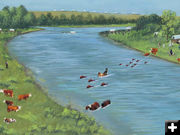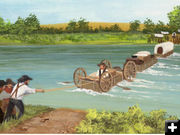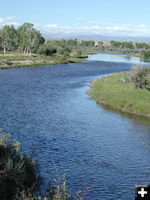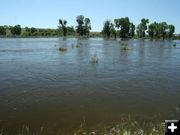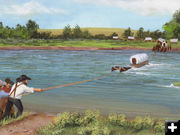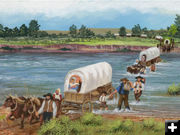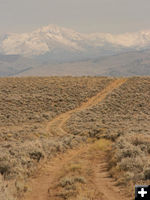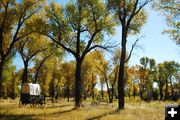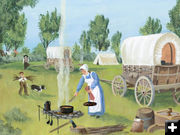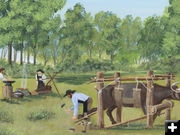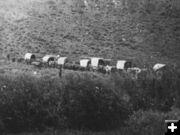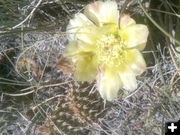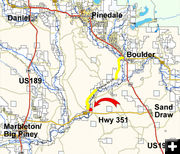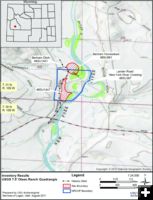

Rooster visitor
A wayward rooster visits the Lander Trail-New Fork River Crossing Historical Park on Saturday, December 16th, 2023.
|

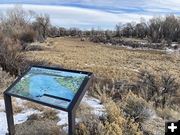
Old river channel
The New Fork River once flowed in this channel, which thousands of emigrants crossed with their wagons and livestock in the mid-1800s. Photo taken Dec. 16, 2023.
|
|
Something to crow about
Lander Trail-New Fork River Crossing Historical Park
by Pinedale Online!
December 18, 2023
This unusual visitor was spotted at the Lander Trail-New Fork River Crossing Historical Park on Saturday, December 16th. The park is owned and operated by the Sublette County Historical Society. The 104-acre park interprets a river crossing location for emigrants on the Lander Cut-Off of the Oregon/California Trail in the mid-1800s. Thousands of emigrants and livestock crossed the river and camped at this location on their way west. There are nine interpretive signs along the rustic one-mile loop walking path through the park which goes down to the New Fork River.
The historical park was made possible by a generous donation by Shell, Ultra, and PacifiCorp in cooperation with the Bureau of Land Management (BLM) as part of mitigation for natural gas drilling activity on the Pinedale Anticline near the historic Oregon/California Trail. The BLM and U.S. Forest Service have done a great job preserving large segments of the Lander Trail in western Wyoming on public land, but very few river crossings are preserved because those typically fell into private ownership during homesteading and were developed. This park location was undeveloped and looks very similar to what it would have looked like when the emigrants were passing through and camped in the lush river bottom among mature cottonwood trees. At this point, emigrants were about half-way along their six-month journey and had just crossed an 18-mile stretch of desert terrain to reach this location. Many took the opportunity to camp at this pretty spot for an extra day or so, do laundry, cook, and let their livestock rest.
This was a difficult river crossing when most emigrants arrived due to high water conditions. Many wagons overturned in the swift current, goods were lost, and some people and livestock drowned trying to cross the deep, fast-moving cold water. After this stopping place, wagon trains soon had another dangerous major river crossing, the Green River, in just five more miles. Plus, there were many more miles of walking along a rough unimproved trail, inclement weather, danger, and hardship ahead of them until they reached their final destination. There are many diary accounts available that document the experience of some of these hardy individuals who made this journey in the 1860s. Use of this trail for emigrant movement to go west trickled off after 1869 once the trans-continental railroad was built 75 miles to the south. After that, the trail was used for travel both west and east by early settlers using wagons and later motorized vehicles.
The gate and parking lot for the New Fork Park are still open as of the time of this article, even though it is late in the year. Typically, the gate get closed in late November or early December once snow shuts things down. This has been an odd year with a late spring and late-coming winter. The park is open year-round, and people can walk-in visit during the winter months, and park at the entrance gate. There is a restroom in the parking lot near the entry. It will be closed once the parking lot gate is closed for winter.
Wildlife is abundant in the park and there is public fishing access along the river bank. Dogs are permitted off-leash – please keep them under control and do not let them chase wildlife.
The park is about a 30-minute drive from Pinedale, Wyoming, on the west side of the New Fork River. From Pinedale, take US 191 south 10 miles to Paradise Road. (If you get to Boulder, you’ve missed the turn and gone too far.) Travel south on the paved Paradise Road another 14 miles almost to Hwy 351. The Park and parking area will be on your left – watch for signs.
For more information about the Lander Trail-New Fork River Historical Park, call the Museum of the Mountain Man in Pinedale at 307-367-4101 or go to www.newforkpark.org.
|


